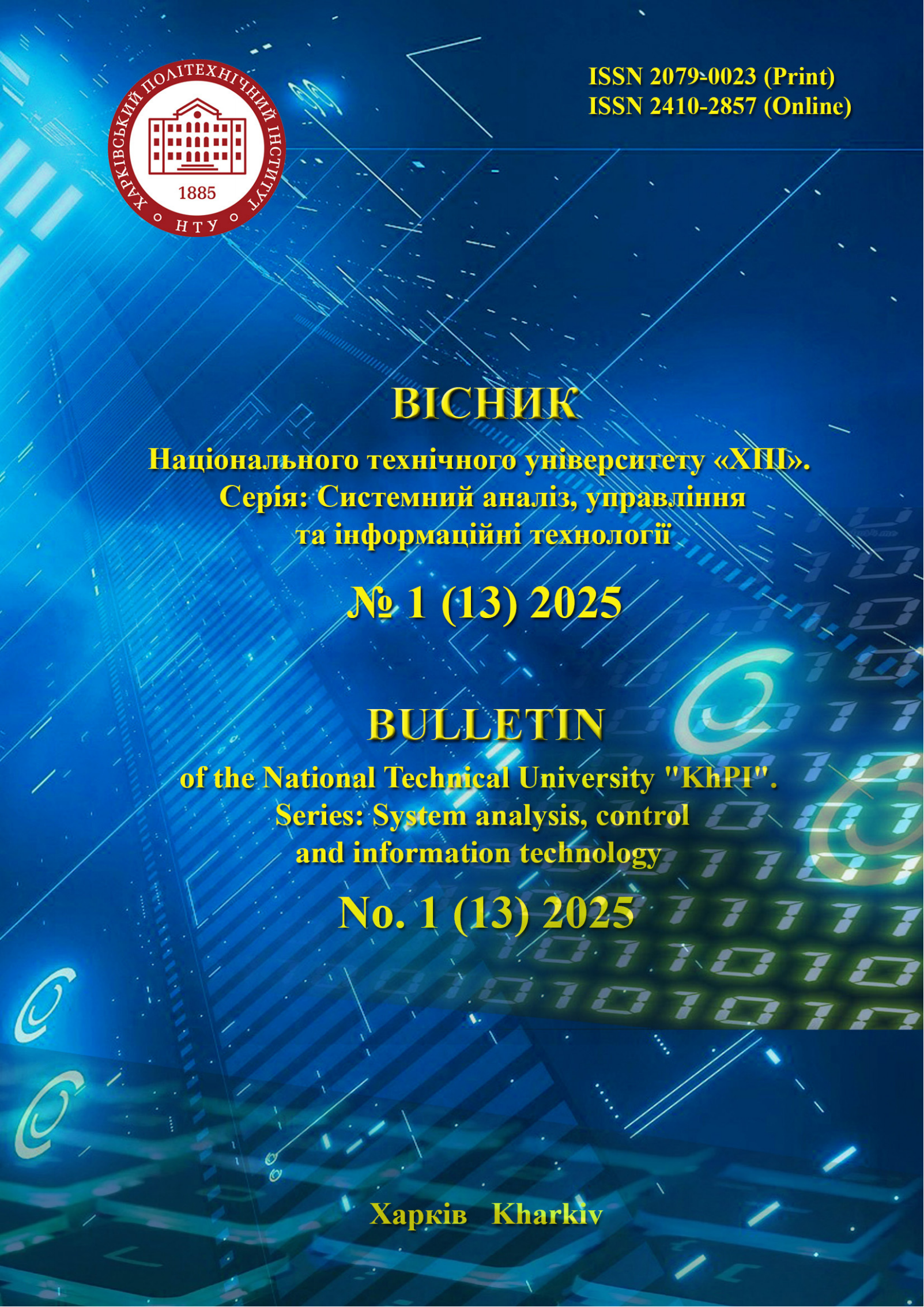COMPARISON OF MODERN GAME ENGINES WITH A CUSTOM CORE FOR NATIVE GAME DEVELOPMENT ON THE ANDROID PLATFORM
DOI:
https://doi.org/10.20998/2079-0023.2025.01.13Keywords:
game engine, ARM, Android, Vulkan, low-level development, Java, C , Rust, energy efficiency, mobile optimizationAbstract
The modern game industry is increasingly focused on mobile platforms, particularly devices based on the ARM architecture, which dominates the smartphone and tablet markets. Developers are actively adapting their engines and tools to this architecture, taking into account its energy efficiency and widespread adoption. In this context, the development of a custom game core that can be installed directly on an Android device without the need for additional engines opens new opportunities for optimization, faster prototyping, and full control over device-level performance. This approach is especially relevant in light of the growing popularity of independent game development and the demand for lightweight solutions without unnecessary dependencies. This study presents a comparative analysis of modern game engines (Unity, Unreal Engine, Godot, Defold, Cocos2d-x) and a custom-developed game core designed for direct installation and execution on Android devices with ARM architecture, without relying on any intermediate engine. The paper examines the advantages of ARM architecture, including energy efficiency, scalability, and broad support in mobile devices, making it a suitable platform for native game development. Particular attention is paid to the technical comparison of engine capabilities, including application size, launch speed, API flexibility, access to system resources, and support for low-level languages. It has been revealed that although traditional engines offer extensive functionality and ease of development, they limit hardware-level control and significantly increase APK size. On the other hand, a custom core, specifically designed for ARM devices, provides minimal size, instant launch, and maximum performance due to direct access to graphical APIs (OpenGL ES/Vulkan) and Android system resources. The study also analyzes the suitability of programming languages such as Java, Kotlin, C++, and Rust for Android game development. It outlines the potential of Vulkan as a high-performance graphics API and discusses the feasibility of a core-centered approach for creating lightweight, optimized mobile games and tools.
References
Keil J., Edler D., Schmitt T., Dickmann F. Creating Immersive Virtual Environments Based on Open Geospatial Data and Game Engines. Journal of Cartography and Geographic Information. 2021, vol. 71, pp.53–65. DOI: https://doi.org/10.1007/s42489-020-00069-6.
Osborne P., Nõmm H., Freitas A.. A Survey of Text Games for Reinforcement Learning Informed by Natural Language. Transactions of the Association for Computational Linguistics. 2022, vol. 10, pp. 873–887. DOI: https://doi.org/10.1162/tacl_a_00495.
Carlos Marín-Lora, Miguel Chover, José M. Sotoca, Luis A. García. A game engine to make games as multi-agent systems. Advances in Engineering Software. 2020, vol. 140, artcle 102732.
DOI: https://doi.org/10.1016/j.advengsoft.2019.102732.
Escobar-Castillejos D., Noguez J., Cárdenas-Ovando R.A., Neri L., Gonzalez-Nucamendi A., Robledo-Rella V. Using Game Engines for Visuo-Haptic Learning Simulations. Applied Sciences. 2020, vol. 10, artcle 4553. DOI: https://doi.org/10.3390/app10134553.
Vohera C., Chheda H., Chouhan D., Desai A., Jain V. Game Engine Architecture and Comparative Study of Different Game Engines. 2021 12th International Conference on Computing Communication and Networking Technologies (ICCCNT), Kharagpur, India, 2021, pp. 1–6, DOI: 10.1109/ICCCNT51525.2021.9579618.
Jangra S., Singh G., Mantri A., Angra S. and Sharma B. Interactivity Development Using Unity 3D Software and C # Programming. 14th International Conference on Computing Communication and Networking Technologies (ICCCNT). Delhi, India, 2023, pp. 1–6. DOI: 10.1109/ICCCNT56998.2023.10308030.
Zhang C., Yu S., Ji J. CFI: a VR motor rehabilitation serious game design framework integrating rehabilitation function and game design principles with an upper limb case. J. NeuroEngineering Rehabil. 2024, vol. 21, article 113. DOI: https://doi.org/10.1186/s12984-024-01373-2.
Chirita A., Neluș-Constantin B., Dragos C. Intel x86 and ARM processors : A survey on architectural differences. 2022. Available. at: https://www.researchgate.net/publication/362105591_Intel_x86_and_ARM_processors_A_survey_on_architectural_differences (accessed: 12.05.2025).
Bibi S., Asghar M., Chaudhry M. U., Hussan N., Yasir M. A Review of ARM Processor Architecture History, Progress and Applications. Journal of Applied and Emerging Sciences. 2021, vol. 10, no. 02, pp. 171–179. Available at: https://www.researchgate.net/publication/354193451_A_Review_of_ARM_Processor_Architecture_History_Progress_and_Applications (accessed: 12.05.2025).
Intel Developer Zone. Envisioning the Future: Simplified Architecture. 2023. Available at: https://www.intel.com/content/www/us/en/developer/articles/technical/envisioning-future-simplified-architecture.html (accessed: 10.05.2025).
Tom’s Hardware. Intel Terminates x86S Initiative: Unilateral Quest to De-bloat x86 Instruction Set Comes to an End. 2023. Available at: https://www.tomshardware.com/pc-components/cpus/intel-terminates-x86s-initiative-unilateral-quest-to-de-bloat-x86-instruction-set-comes-to-an-end (accessed: 05.2025).
Unity Technologies. Compare Plans. Available at: https://unity.com/products/compare-plans (accessed: 10.05.2025).
Epic Games. Unreal Engine End User License Agreement. Available at: https://www.unrealengine.com/en-US/license (accessed: 10.05.2025).
Godot Engine. Godot – Open Source Game Engine [GitHub]. Available at: https://github.com/godotengine/godot (accessed: 10.05.2025).
Defold Foundation. Defold – Game Engine [GitHub]. Available at: https://github.com/defold (accessed: 10.05.2025)..
Cocos2d-x.org. Cocos2d-x [GitHub]. Available at: https://github.com/cocos2d/cocos2d-x (accessed: 10.05.2025).
Google Security Blog. Memory-safe languages in Android 13 .2022. Available at: https://security.googleblog.com/2022/12/memory-safe-languages-in-android-13.html (accessed: 10.05.2025)..
Android Authority. Java vs C++ App Performance. Available at: https://www.androidauthority.com/java-vs-c-app-performance-689081 (accessed: 10.05.2025).
LeanIX Engineering. Sustainable Green Software Engineering. Available at: https://engineering.leanix.net/blog/sustainable-green-software-engineering (accessed: 10.05.2025).
Android Developers. Kotlin for Android Development. Available at: https://developer.android.com/kotlin (accessed: 10.05.2025)..
Android Source. Building Rust Modules for Android. Available at: https://source.android.com/docs/setup/build/rust/building-rust-modules/overview (accessed: 10.05.2025)..
ARM Community. Initial Comparison of Vulkan API vs OpenGL ES API on ARM. Available at: https://community.arm.com/arm-community-blogs/b/mobile-graphics-and-gaming-blog/posts/initial-comparison-of-vulkan-api-vs-opengl-es-api-on-arm (accessed: 10.05.2025).
Android Developers. Vulkan API Overview. Available at: https://developer.android.com/games/develop/vulkan/overview (accessed: 10.05.2025).
Downloads
Published
How to Cite
Issue
Section
License

This work is licensed under a Creative Commons Attribution 4.0 International License.
Authors who publish with this journal agree to the following terms:
- Authors retain copyright and grant the journal right of first publication with the work simultaneously licensed under a Creative Commons Attribution License that allows others to share the work with an acknowledgement of the work's authorship and initial publication in this journal.
- Authors are able to enter into separate, additional contractual arrangements for the non-exclusive distribution of the journal's published version of the work (e.g., post it to an institutional repository or publish it in a book), with an acknowledgement of its initial publication in this journal.
- Authors are permitted and encouraged to post their work online (e.g., in institutional repositories or on their website) prior to and during the submission process, as it can lead to productive exchanges, as well as earlier and greater citation of published work (See The Effect of Open Access).


